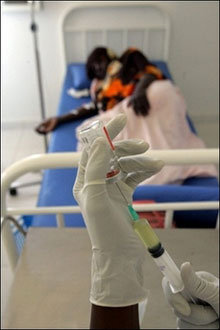Proteins found that AIDS virus preys on
Updated: 2008-01-11 07:06
WASHINGTON - The AIDS virus has to hijack human proteins to do its damage, but scientists until now have known only a few dozen of its targets. On Thursday, Harvard researchers unveiled a surprisingly longer list, an important first step in the hunt for new drugs.
 A nurse prepares an injection for an HIV patient at a treatment centre in Nouakchott. [Agencies] |
HIV is on its face a simple virus, consisting of just nine genes. Yet it makes up for that bare-bones structure in a sinister and complex way -- by literally taking over the cellular machinery of its victims so it can multiply and then destroy.
The proteins it exploits have been dubbed HIV dependency factors, and 36 had been discovered. The new research, published online Thursday by the journal Science, found 273 of these potential HIV targets.
Led by geneticist Stephen Elledge of Brigham and Women's Hospital, the team used a technique called RNA interference that can disrupt a gene's ability to do its job and make a protein. One by one, they disrupted thousands of human genes in test tubes, dropped in some HIV, and watched what happened. If HIV couldn't grow well, it signaled the protein that the gene that had failed to produce must be the reason.
It will take far more research to figure out the role each of these proteins plays in HIV's life cycle.
But most of today's AIDS drugs work by targeting the HIV virus itself. In August, the government approved sale of the first drug that works by blocking an HIV dependency factor, a cellular doorway called CCR5. The hope is that this longer list of those factors will point toward spots where similar drugs might work.
|
|
|
||
|
||
|
|
|
|